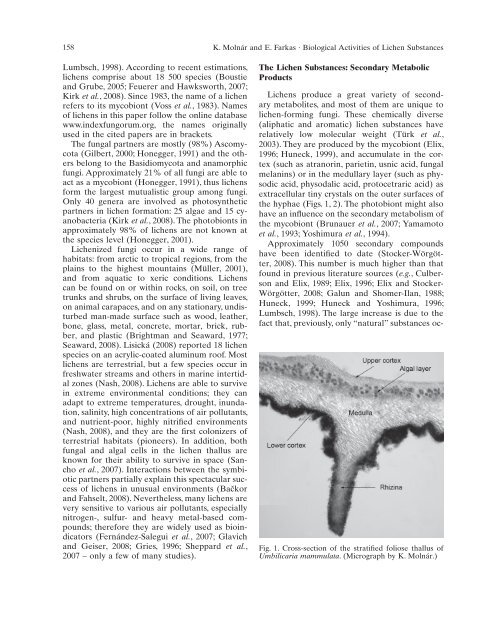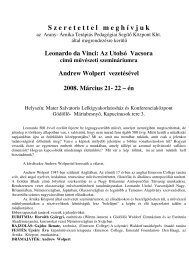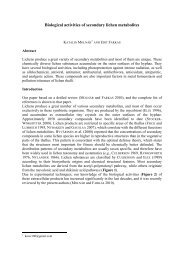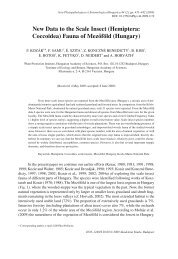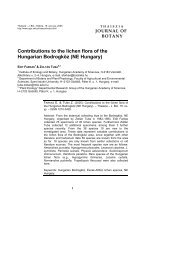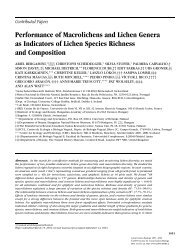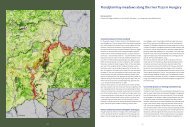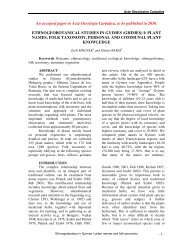Current Results on Biological Activities of Lichen ... - Lichens and Me
Current Results on Biological Activities of Lichen ... - Lichens and Me
Current Results on Biological Activities of Lichen ... - Lichens and Me
You also want an ePaper? Increase the reach of your titles
YUMPU automatically turns print PDFs into web optimized ePapers that Google loves.
158 K. Molnár <strong>and</strong> E. Farkas · <strong>Biological</strong> <strong>Activities</strong> <strong>of</strong> <strong>Lichen</strong> Substances<br />
Lumbsch, 1998). According to recent estimati<strong>on</strong>s,<br />
lichens comprise about 18 500 species (Boustie<br />
<strong>and</strong> Grube, 2005; Feuerer <strong>and</strong> Hawksworth, 2007;<br />
Kirk et al., 2008). Since 1983, the name <strong>of</strong> a lichen<br />
refers to its mycobi<strong>on</strong>t (Voss et al., 1983). Names<br />
<strong>of</strong> lichens in this paper follow the <strong>on</strong>line database<br />
www.indexfungorum.org, the names originally<br />
used in the cited papers are in brackets.<br />
The fungal partners are mostly (98%) Ascomycota<br />
(Gilbert, 2000; H<strong>on</strong>egger, 1991) <strong>and</strong> the others<br />
bel<strong>on</strong>g to the Basidiomycota <strong>and</strong> anamorphic<br />
fungi. Approximately 21% <strong>of</strong> all fungi are able to<br />
act as a mycobi<strong>on</strong>t (H<strong>on</strong>egger, 1991), thus lichens<br />
form the largest mutualistic group am<strong>on</strong>g fungi.<br />
Only 40 genera are involved as photosynthetic<br />
partners in lichen formati<strong>on</strong>: 25 algae <strong>and</strong> 15 cyanobacteria<br />
(Kirk et al., 2008). The photobi<strong>on</strong>ts in<br />
approximately 98% <strong>of</strong> lichens are not known at<br />
the species level (H<strong>on</strong>egger, 2001).<br />
<strong>Lichen</strong>ized fungi occur in a wide range <strong>of</strong><br />
habitats: from arctic to tropical regi<strong>on</strong>s, from the<br />
plains to the highest mountains (Müller, 2001),<br />
<strong>and</strong> from aquatic to xeric c<strong>on</strong>diti<strong>on</strong>s. <strong>Lichen</strong>s<br />
can be found <strong>on</strong> or within rocks, <strong>on</strong> soil, <strong>on</strong> tree<br />
trunks <strong>and</strong> shrubs, <strong>on</strong> the surface <strong>of</strong> living leaves,<br />
<strong>on</strong> animal carapaces, <strong>and</strong> <strong>on</strong> any stati<strong>on</strong>ary, undisturbed<br />
man-made surface such as wood, leather,<br />
b<strong>on</strong>e, glass, metal, c<strong>on</strong>crete, mortar, brick, rubber,<br />
<strong>and</strong> plastic (Brightman <strong>and</strong> Seaward, 1977;<br />
Seaward, 2008). Lisická (2008) reported 18 lichen<br />
species <strong>on</strong> an acrylic-coated aluminum ro<strong>of</strong>. Most<br />
lichens are terrestrial, but a few species occur in<br />
freshwater streams <strong>and</strong> others in marine intertidal<br />
z<strong>on</strong>es (Nash, 2008). <strong>Lichen</strong>s are able to survive<br />
in extreme envir<strong>on</strong>mental c<strong>on</strong>diti<strong>on</strong>s; they can<br />
adapt to extreme temperatures, drought, inundati<strong>on</strong>,<br />
salinity, high c<strong>on</strong>centrati<strong>on</strong>s <strong>of</strong> air pollutants,<br />
<strong>and</strong> nutrient-poor, highly nitrified envir<strong>on</strong>ments<br />
(Nash, 2008), <strong>and</strong> they are the first col<strong>on</strong>izers <strong>of</strong><br />
terrestrial habitats (pi<strong>on</strong>eers). In additi<strong>on</strong>, both<br />
fungal <strong>and</strong> algal cells in the lichen thallus are<br />
known for their ability to survive in space (Sancho<br />
et al., 2007). Interacti<strong>on</strong>s between the symbiotic<br />
partners partially explain this spectacular success<br />
<strong>of</strong> lichens in unusual envir<strong>on</strong>ments (Bačkor<br />
<strong>and</strong> Fahselt, 2008). Nevertheless, many lichens are<br />
very sensitive to various air pollutants, especially<br />
nitrogen-, sulfur- <strong>and</strong> heavy metal-based compounds;<br />
therefore they are widely used as bioindicators<br />
(Fernández-Salegui et al., 2007; Glavich<br />
<strong>and</strong> Geiser, 2008; Gries, 1996; Sheppard et al.,<br />
2007 – <strong>on</strong>ly a few <strong>of</strong> many studies).<br />
The <strong>Lichen</strong> Substances: Sec<strong>on</strong>dary <strong>Me</strong>tabolic<br />
Products<br />
<strong>Lichen</strong>s produce a great variety <strong>of</strong> sec<strong>on</strong>dary<br />
metabolites, <strong>and</strong> most <strong>of</strong> them are unique to<br />
lichen-forming fungi. These chemically diverse<br />
(aliphatic <strong>and</strong> aromatic) lichen substances have<br />
relatively low molecular weight (Türk et al.,<br />
2003). They are produced by the mycobi<strong>on</strong>t (Elix,<br />
1996; Huneck, 1999), <strong>and</strong> accumulate in the cortex<br />
(such as atranorin, parietin, usnic acid, fungal<br />
melanins) or in the medullary layer (such as physodic<br />
acid, physodalic acid, protocetraric acid) as<br />
extracellular tiny crystals <strong>on</strong> the outer surfaces <strong>of</strong><br />
the hyphae (Figs. 1, 2). The photobi<strong>on</strong>t might also<br />
have an influence <strong>on</strong> the sec<strong>on</strong>dary metabolism <strong>of</strong><br />
the mycobi<strong>on</strong>t (Brunauer et al., 2007; Yamamoto<br />
et al., 1993; Yoshimura et al., 1994).<br />
Approximately 1050 sec<strong>on</strong>dary compounds<br />
have been identified to date (Stocker-Wörgötter,<br />
2008). This number is much higher than that<br />
found in previous literature sources (e.g., Culbers<strong>on</strong><br />
<strong>and</strong> Elix, 1989; Elix, 1996; Elix <strong>and</strong> Stocker-<br />
Wörgötter, 2008; Galun <strong>and</strong> Shomer-Ilan, 1988;<br />
Huneck, 1999; Huneck <strong>and</strong> Yoshimura, 1996;<br />
Lumbsch, 1998). The large increase is due to the<br />
fact that, previously, <strong>on</strong>ly “natural” substances oc-<br />
Fig. 1. Cross-secti<strong>on</strong> <strong>of</strong> the stratified foliose thallus <strong>of</strong><br />
Umbilicaria mammulata. (Micrograph by K. Molnár.)


